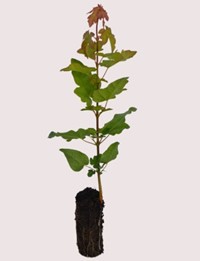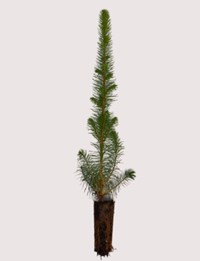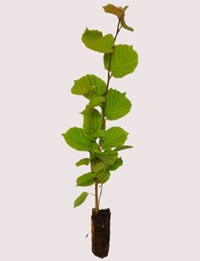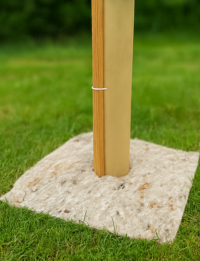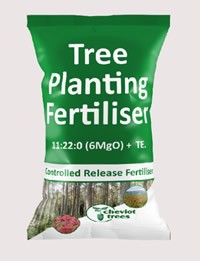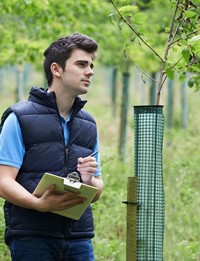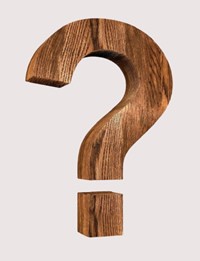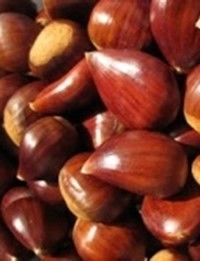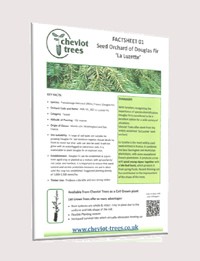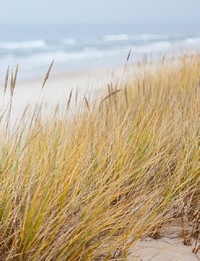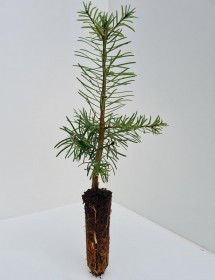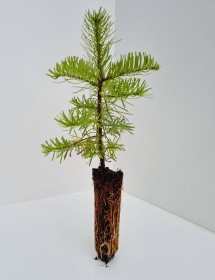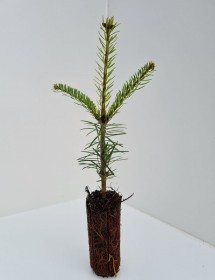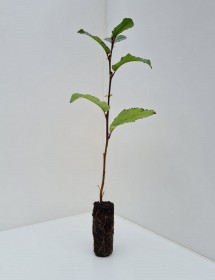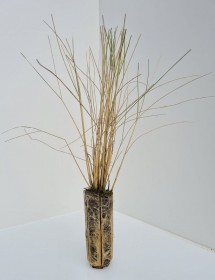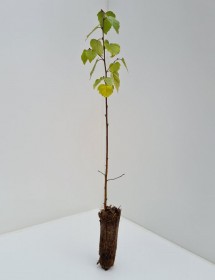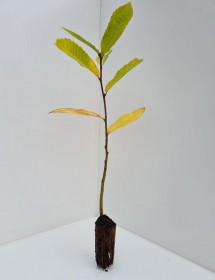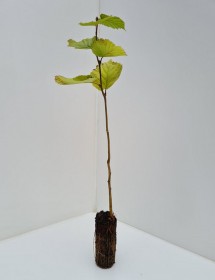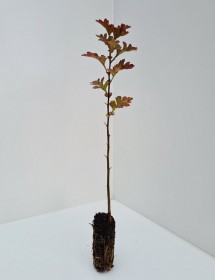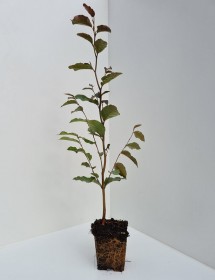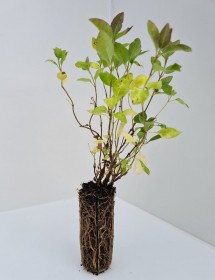
Cell Grown Plants
Every year our nursery in the Scottish Borders produces millions of cell grown broadleaves, conifers, shrubs, hedging plants and a range of other species for environmental planting. Our species range is extensive and we have species to suit all planting objectives.
Cell grown plants can be planted almost all year round and offer excellent survivability as they are supplied with a complete and intact fibrous root system.
-
Abies alba - European Silver Fir
£1.98from £0.88Abies alba - Silver fir is a long-living conifer upright-growing evergreen conifer with dark green needles that are silver underneath. The yellow-green cones which appear in late spring are cylindrical in shape and ripen to brown.
The strong, lightweight timber is mainly used for construction, furniture, plywood and pulpwood. Young trees are also popular as Christmas trees. Ecologically, the tree is important for maintaining high biodiversity in forested areas. The tree’s deep taproots offering stability, alongside its easily biodegradable needle litter, are key in the establishment and management of silvicultural systems.
Silver fir is shade-tolerant and able to act as a “seedling bank” under the canopy of older dominant trees for decades.
-
Abies fraserii - Fraser Fir
£1.98from £0.88Abies fraserii - Fraser Fir is a fast growing, large evergreen with dark green needles that have a silver grey underside.
Originally from the USA, this species is most frequently planted in the UK for Christmas tree crops as it has a dense, busy habit when young. Fraser Fir has a narrower and more compact shape than Nordmann Fir so is often suited to smaller rooms in houses if it is grown to then be supplied as a cut Christmas tree.
We grow several other species of cell grown conifers which are all suited for Christmas tree production.
-
Abies grandis - Grand Fir
£1.82from £0.81Abies grandis - Grand Fir is a very large and stately evergreen conifer that has a very fast rate of growth.
It is one of several north west American species discovered by the well known plant hunter, David Douglas who sent seeds back to the UK in 1831.
Needles are dark green and grooved on top with two white bands. A very shade tolerant species that is ideally suited for underplanting in continuous cover forestry but it is equally as impressive when grown as a specimen tree.
-
Abies nobilis - Noble Fir
£1.82from £0.81Abies nobilis - Noble Fir is a well regarded evergreen conifer that has a very high tolerance of exposure and it is often planted in the uplands.
It is one of several north west American species discovered by the well known plant hunter, David Douglas who sent seeds back to the UK in 1831.
Needles are blue grey in colour and are upcurved. A popular species for Christmas tree production due to its steady growth, attractive shape, good needle retention qualities and desirable foliage colour.
We grow several other species of cell grown conifers which are all suited for Christmas tree production.
-
Abies nordmanniana - Nordman Fir
£1.98from £0.88Abies nordmanniana - Nordman Fir is the best selling species for Christmas tree production.
It has luscious soft dark green needles, a symmetrical shape, and excellent needle retention qualities.
We grow several other species of cell grown conifers which are all suited for Christmas tree production.
-
Acer campestre - Field Maple
£1.52from £0.67Acer campestre - Field maple is a versatile and resilient fast growing small to medium sized tree that is also suitable for hedgerow planting.
It is a colourful species; the attractive five lobed leaves are flushed red in Spring, turning green and then yellow / gold in the Autumn. Deciduous. Native to the UK
Our cell grown Field Maple plants are often used for hedge planting either on their own or mixed with other species such as Hawthorn, Blackthorn, Hazel etc. Usually at a planting density of 6 plants per metre.
-
Acer platanoides - Norway Maple
£1.98from £0.88Acer platanoides - Norway Maple is a beautiful fast growing tree of large stature which is best suited to parkland or settings where its superb autumn colour can be fully appreciated.
Deciduous. Native to Central / Eastern but widely adapted to the UK. Norway Maple has a typical maple shaped leave which turns bright yellow in the autumn.
-
Acer pseudoplatanus - Sycamore
£1.82from £0.81Acer pseudoplatanus - Sycamore. The marmite of forestry that needs little or no introduction. Undemanding, tolerant, and productive.
Deciduous. A native to central and southern Europe but is considered by some to be an honorary native to the UK. Simple, large green leaves and interesting grey, flaky bark.
We produce this species from multiple seed sources including an Improved seed source. The breeding work to produce the Improved seed was carried out by the Future Trees Trust.
-
Alnus cordata - Italian Alder
£1.70from £0.74Alnus cordata - Italian Alder is a fast growing, medium sized tree which grows in most soils except heavy clay. Tough and hardy with nitrogen fixing qualities. Often used on reclamation or hostile sites.
Bright green glistening foliage preceded by yellow catkins that appear in late winter. Ideal for forming a windbreak or for companion planting with species such as Douglas Fir and Sitka Spruce.
-
Alnus glutinosa - Common Alder
£1.52from £0.67Alnus glutinosa - Common Alder, is a medium to large sized tree liking a natural habit of damp ground near rivers and lochs, but it is equally found in mixed woodlands on drier ground.
-
Alnus rubra - Red Alder
£1.70from £0.74Alnus rubra - Red Alder shares many of the features of our native Common Alder and is ideal for forming a windbreak or for companion planting with species such as Douglas Fir and Sitka Spruce.
-
Ammophila arenaria - Marram Grass
£1.85from £0.75We are specialist growers of Ammophila arenaria - Marram Grass plants from British seed for coastal erosion projects.
Marram Grass is our native coastal grass and it does a fantastic job of helping to stabilise sand dunes protecting coastal defences.
It grows from a network of underground rhizomes which give it a sturdy anchor to the sand and allow it to spread upwards.
Growing in stiff, hardy clumps the foliage is grey green in colour and it produces light brown flowerheads.
Suggested planting density: 5 plants per square metre.
-
Betula pendula - Silver Birch
£1.52from £0.67Betula pendula - Silver Birch is one of the UK’s most well-known and hardiest native trees which offer so much interest due to its graceful habit and papery/peeling white bark with brown contrast.
Deciduous. A true pioneer species which rapidly colonises open areas and supports over 300 species of insect. Silver Birch is one of the most productive broadleaves species in Scandinavian countries and a multifunctional species for the UK. Excellent planted as a mixture with other species, superb as a windbreak and provides excellent quality firewood!
We produce this species from multiple seed sources including an Improved seed source. The breeding work to produce the Improved seed was carried out by the Future Trees Trust.
-
Betula pubescens - Downy Birch
£1.52from £0.67Betula pubescens - Downy Birch is probably one of the toughest native species. Its range extends into the artic, more northerly than any other broadleaved species!
Deciduous. It is similar in appearance to Silver Birch but has a more upright habit and a darker bark.
-
Buxus sempervirens - Box
£2.13from £1.28The majority of the Buxus sempervirens - Box plants that we supply are used for hedging as it makes a fabulous formal hedge, but our clients also use it for planting as an understorey species in mixed woodlands or for game cover.
Evergreen with small, shiny dark green leaves. It is a very long lived species and can live for several hundred years.
-
Calluna vulgaris - Native Wild Heather
£1.82from £0.81Calluna vulgaris - Native Wild Heather is the dominant heath plant in many parts of the UK. It has a wide range and is widely distributed throughout Europe as far North as the Faroe Islands.
Mauve pink flowers bloom from July to September which create a colourful scene in the countryside.
Native heather is an important source of food for butterflies and bees with hives often located on heather moorland in the Summer where the bees can easily obtain the nectar from the heather flowers to produce a very distinctive and much sought after ‘heather honey’.
The majority of the plants that we supply are used for heathland restoration projects in the countryside or on golf courses.
-
Carpinus betulus - Hornbeam
£1.82from £0.81Carpinus betulus - Hornbeam is an excellent versatile species which can either be used for forestry purposes or for hedging. If grown for hedging the leaves will stay on throughout most of the winter.
-
Castanea sativa - Sweet Chestnut
£1.98from £0.88Castanea sativa - Sweet Chestnut is a good example of a multi functional species. Excellent as a parkland tree, great for coppicing, and the chestnuts provide a tasty treat for red squirrels!
Native to Southern Europe but thought to be introduced by the Romans, Sweet Chestnut is found throughout the UK and is commonly associated with Southern England. Deciduous with long, narrow glossy leaves.
-
Cedrus atlantica - Atlas Cedar
£2.13from £1.03Cedrus atlantica - Atlas Cedar is a large evergreen conifer with silvery blue needles. The branches are horizontal and stiff.
Native to Morocco and Algeria in the Atlas Mountains where it is often grown as a pure stand. It is the only African tree that thrives in the UK, and most of the plants that we produce are used by our customers in the Southern and Eastern areas of the UK, as it is capable of withstanding periods of drought once established.
It produces strong and durable timber that is renowned for its strong and persistent fragrance.
Learn more about Atlas Cedar by reading our factsheet.
-
Cornus alba - Red Dogwood
£1.52from £0.67Cornus alba - Red Dogwood is a shrub that grows well in wet soils and is normally found along woodland edges and in hedgerows. It is a good choice for game cover.
Red Dogwood is grown mainly for its bright red stems. Deciduous with fresh green leaves that have distinctive curved veins. The leaves turn a rich crimson colour in the Autumn.
Creamy white flowers are produced in clusters which once pollinated by insects develop into small black berries which are eaten by birds and mammals.
Our cell grown Cornus alba - Red Dogwood plants are often used for hedge planting either on their own or mixed with other species such as Hawthorn, Blackthorn, Dog rose etc. at a planting density of 6 plants per metre.
-
Cornus sanguinea - Common Dogwood
£1.52from £0.67Cornus sanguinea - Common Dogwood is a native shrub that grows well is wet soils and is normally found along woodland edges and in hedgerows. It is a good choice for game cover.
Deciduous with fresh green leaves that have distinctive curved veins. The leaves turn a rich crimson colour in the Autumn.
Creamy white flowers are produced in clusters which once pollinated by insects develop into small black berries which are eaten by birds and mammals.
Our cell grown Dogwood plants are often used for hedge planting either on their own or mixed with other species such as Hawthorn, Blackthorn, Dog rose etc at a planting density of 6 plants per metre.
-
Corylus avellana - Hazel
£1.82from £0.81Corylus avellana - Hazel is a small shrubby tree which is often found in mixed native woodlands and hedgerows.
It is well known for its long yellow catkins which appear in the Spring and then produces hazelnuts in the summer. Native to the UK.
Our cell grown Hazel plants are often used for hedge planting either on their own or mixed with other species such as Hawthorn, Blackthorn, Dog Rose etc. at a planting density of 6 plants per metre.
-
Cotoneaster lacteus - Milkflower Cotoneaster
£1.93from £0.93Cotoneaster lacteus - Milkflower Cotoneaster is a dense evergreen shrub that can be used for an informal hedge or screen.
Its main attraction is the clusters of creamy white flowers which persist all summer and then masses of red berries are produced in the autumn and stay on the plant until the winter.
This species has a wide arching habit with large leathery leaves with deep veins which have a furry underside.
-
Crataegus monogyna - Hawthorn
£1.60from £0.70Crataegus monogyna - Hawthorn is the backbone of most British hedgerows and is one of the first species to produce new leaves in the Spring. If left untrimmed it will grow into a small tree with a very dense crown.
A very showy native species with fragrant, creamy white flowers in the Spring followed by green haws (berries) turning red in autumn.
Spiny, dense deciduous foliage which provides an excellent habitat for birds and insects.
Our cell grown Hawthorn plants are often used for hedge planting either on their own or mixed with other species such as Crab Apple, Blackthorn, Dog Rose etc. at a planting density of 6 plants per metre.
-
Cryptomeria japonica - Japanese Red Cedar
£1.82from £0.81Cryptomeria japonica - Japanese Red Cedar is a large evergreen tree with green, dense foliage that turns bronze in Winter.
Introduced into Britain in 1879, the Japanese Red Cedar has demonstrated its ability to produce a yield that is comparable to other commonly used conifers in the UK such as Douglas Fir & Western Red Cedar. It’s expansion into UK is likely to be in areas with a warm, moist maritime climate such as W. Scotland, Wales and SW England.
There is limited experience of processing the timber in the UK but in its native range it is highly regarded as a major construction timber and is also often used in exterior, ground contact applications as the timber has good natural durability.
Learn more on this Fact Sheet.
-
Cuppressocyparis leylandii - Leylandii
£3.64from £1.73Leylandii is a large evergreen conifer that is most commonly utilised for hedging or screening purposes.
Tough, Fast growing and tolerant of most conditions.
The foliage is dense, dark green in colour and flat in shape. We also produce Golden Leylandii.
If you are planting for hedging/screening you may also wish to consider Western Red Cedar. This species is equally as fast growing but has a tighter shape and a richer shade of green.
-
Cupressocyparis leylandii Castlewellan Gold -...
£3.64from £1.73Cupressocypairs leylandii Castlewellan Gold - Golden leylandii is a large evergreen conifer that is most commonly utilised for hedging or screening purposes.
Tough, Fast growing and tolerant of most conditions.
The new growth is strikingly golden yellow in colour. We also produce Green Leylandii.
If you are planting for hedging/screening you may also wish to consider Western Red Cedar. This species is equally as fast growing but has a tighter shape and a richer shade of green.
-
Cytisus scoparius - Broom
£1.98from £0.88Cytisus scoparius - Broom is a large, native shrub that is often found on heathland, woodland and coastal areas.
It thrives in poor soil and is a useful plant for stablising soil.
It produces bright yellow flowers in the Spring which smell of vanilla. The flowers then ripen into seed pods which crack open in the Summer.
There are many different varieties of Broom but we produce the native type from seed.
-
Eucalyptus dalrympleana - Mountain Gum
£2.13from £1.03Eucalyptus dalrympleana - Mountain Gum is one of the most popular species of Eucalypts grown in the UK due to its cold tolerance properties. A fast growing species which is very productive and adaptable to many purposes including biomass production, firewood, screening and foliage production.
Evergreen with ovate foliage which is copper tinged in colour when juvenile, turning blue/ green. Like most Eucalypts, the bark is often equally as impressive as the foliage and this species does not disappoint with shades of white and grey.
-
Empetrum nigrum - Crowberry
£1.93from £0.93Cheviot Trees are specialist producers of native moorland plants such as Empetrum nigrum - Crowberry.
A mat forming shrub with tiny purple, stalkless starry flowers that have stubby, needle like leaves. The fruit is a shiny black berry which is initially green, then turning pink, purple and finally black.
Often bound growing in acidic soils in shady, wet areas. Found on moors, bogs and wet slopes.
-
Erica tetralix - Cross leaved Heath
£1.93from £0.93The cross leaved heath is native to the UK and is often found on heathland and moors.
Shrubby in habit, it produces small pink bell shaped flowers that are produced in clusters at the end of its shoots. Narrow grey-green leaves which are arranged in fours around the stem, hence the name.
-
Eriophorum angustifolium - Cottongrass
£1.68from £0.68Eriophorum angustifolium - Cottongrass (often referred to as bog cotton) is an evergreen perennial that forms vigorously spreading clumps. It enjoys the harshest of environments - boggy, open, peat areas where there is little other competition.
Pure white silky haired seed heads form after flowering. Cottongrass seeds and stems are edible and can used for medicinal purposes. The fluffy seed heads have also been used as a substitute to stuffing pillows.
It provides an excellent habituate for wildlife and is a pond essential.
-
Eriophorum vaginatum - Hare's Tail Cottongrass
£1.68from £0.68Eriophorum vaginatum – Hares Tail Cottongrass is a native evergreen perennial.
Less well known than the Common Cottongrass, Hares Tail Cottongrass forms compact clumps with silky white tufts that resemble hares tails. Each shoot produces only one head of flowers, unlike the common Cottongass.
Often found in wet heaths, bogs and moors but also happy in a pond margin.
We produce large volumes of this species for peatland restoration projects.
-
Euonymus europeaus - Spindle
£1.84from £0.89Spindle hedging plants provide a wonderful array of autumn colour. The four-lobed capsules burst into life with a vibrant shade of pink, opening to reveal orange fruits in the autumn. Euonymus europaeus hedging plants have dark green foliage that transforms into rich shades of red and yellow in autumn, adding another layer of colour to your garden. Spindle produces a dense hard wood that was traditionally used for making spindles and small implements.
A fast-growing species, Spindle is ideal for giving an array of colour to a hedge and is an excellent attractor of wildlife.
-
Fagus sylvatica - Green Beech
£1.82from £0.81Fagus sylvatica - Green Beech is one of the most widely planted broadleaved trees in Europe. A long lived species that is commonly used in the UK as a component in a mixed woodland, for hedging or for parkland planting due its very broad crown.
Smooth, silver grey bark. Dark green leaves turning yellow then copperin autumn. The leaves are retained on the plant during the winter if the plant is maintained as a hedge. If you are comparing Beech or Hornbeam for hedging and you have damp soil and or you are in a cold exposed area then we would suggest using Hornbeam.
-
Fagus sylvatica atropurpurea - Copper Beech
£3.64from £2.18Fagus sylvatica atropurpurea - Copper Beech is a vibrant and stunning variety of Beech that forms a very large specimen tree in a parkland setting. Very eye catching and perfectly suited for hedge planting either on its own or mixed with Green Beech.
Smooth, silver grey bark. Deep purple leaves in the Spring and Summer turning yellow then copper in autumn. The leaves are retained on the plant during the winter if the plant is maintained as a hedge. If you are comparing Beech or Hornbeam for hedging and you have damp soil and or you are in a cold exposed area then we would suggest using Hornbeam.
-
Ilex aquifolium - Holly
£3.34from £1.47A classic, native evergreen hedging plant, Ilex aquifolium - Holly growth rate is fairly slow at about 10-20cm a year, but what these hedging plants lack in speed, they make up for with seasonal interest and colourful foliage.
As a native hedging plant, Ilex is great for providing food and shelter to British wildlife. Birds such as blackbirds, chaffinches, robins and waxwings feast on the bright red berries and Holly plants provide a good source of nectar and pollen for bees. Holly hedging is the most beneficial to wildlife when left to grow naturally, as the bushy habit provides a safe, protected habitat
-
Juglans nigra - Black Walnut
£3.64from £1.73Juglans nigra - Black Walnut is a large fast growing species. We primarily grow this species for our forestry customers as the timber is highly valued, but it is also worth considering for its ornamental attributes.
Introduced to the UK from North America some 400 years ago, Black Walnut has a lot to offer.
The timber of Black Walnut is heavy, strong and durable with a value of 3-4 times that of Oak.
The foliage is pinnate with individual oval pointed leaflets which turn yellow in autumn.
Flowers appear in early Summer in the form of long catkins and in the Autumn the flowers turn to brownish green fruits that are around the size of a plum. The brown nut is held inside the husk.
We also produce Juglans regia - Common Walnut.
-
Juglans regia - English Walnut
£3.64from £1.73Juglans regia - English Walnut is a large fast growing species. A well known tree which was first introduced by the Romans who valued its nuts. Native from South-East Europe to South-west China.
Widely planted throughout the UK an it makes a fantastic and well shaped specimen for planting in parkland area, avenues, riverbanks and as a hedgerow tree.
The timber is equally as valuable as the nuts and can be used for furniture manufacture and veneer.
The foliage is shiny, pinnate with individual oval pointed leaflets which turn yellow in autumn.
Flowers appear in early Summer in the form of long catkins and in the Autumn the flowers turn to brownish green fruits that are around the size of a plum. The brown nut is held inside the husk.
We also produce Juglans nigra - Black Walnut.
-
Juniperus communis - Common Juniper
£3.34from £1.47Juniperus communis - Juniper is a small evergreen conifer that is native to the UK.
Small green needles with a prickly point. Juniper is dioecious so the male and female flowers grown on separate plants. Once pollinated by wind the female flowers develop into fleshy purple berries.
The berries are popular for flavouring gin but they are equally favoured birds who eat the berries. Juniper is also an important habitat for small mammals and nesting birds due the dense cover that it provides.
-
Larix decidua - European Larch
£1.46from £0.59Larix decidua - European larch is one of the few deciduous conifers.
It has a lot to offer. It is tough and robust, provides strong durable timber and offers fantastic landscape value in the Autumn when its foliage changes to a golden yellow colour.
Its native range is the mountainous regions in Central and Eastern Europe where it grows well at high elevations. It has grown successfully in the UK since it was introduced in the early 17th century.
The timber is noted for its hardness, strength, and natural durability so it is often used for exterior purposes. The seeds are a tasty treat for red squirrels!
We also produce Hybrid Larch.
-
Ligustrum ovalifolium - Oval Leaved Privet
£1.93from £0.93Ligustrum ovalifolium – Oval leaf privet is a fast growing semi evergreen hedging species with glossy dark green leaves and creamy white flowers during the summer months.
A robust species which tolerates regular pruning. Also suitable for coastal locations although you may notice some defoliation during winter.
You may also wish to consider Wild Privet which has narrower leaves and a looser growing habit.
Creamy white flowers during the summer months.
-
Ligustrum vulgare - Wild Privet
£1.98from £1.22Ligustrum vulgare - Wild Privet is a bushy, native shrub that we often supply as part of a native hedge mixture but it is also useful on the edge of woodlands or as game cover due to its good tolerance of shade.
It is semi evergreen so provides useful cover and shelter for wildlife in the winter thanks to its relatively untidy and gnarly habit.
Semi evergreen with thin, green pointed leaves. Small white flowers are produced in the Summer with dark purple berries that follow in the Autumn.
You may also wish to consider Oval Leaf Privet which has larger oval leaves with better retention properties.
-
Lonicera nitida - Boxleaf Honeysuckle
£3.34from £1.47Lonicera nitida, commonly known as the Boxleaf Honeysuckle due to its small box type leaf that is pale green in colour.
It has as looser habit when compared against box so it should not be first choice for formal hedging but it is useful for planting on woodland edges as it offers good winter shelter and interest.
Fast growing and evergreen with small white flowers appearing in Spring.
-
Lonicera periclymenum - Honeysuckle
£3.34from £2.01Lonicera periclymenum - Honeysuckle is useful addition to a native hedgerow as it can easily scramble its way through the hedge, knitting everything together.
Deciduous. The main interest beings is the trumpet like flowers which attract wildlife in their masses. The flowers are sweet in fragrance are rich in nectar and are particularly attractive to moths.
Berries follow in the autumn which are eaten by birds who also use the dense branches as nesting sites.
You don’t need many Honeysuckle in a hedge to make an impact. A ration fo around 5% of your total mixture is more than sufficient.
-
Malus sylvestris - Crab Apple
£1.62from £0.70Malus sylvestris - Crab Apple is a good multi purpose native species. Good as part of a mixed hedge or woodland.
Deciduous. Glossy, oval leaves which has rounded teeth and sweetly scented blossom in the Spring which is pollinated by insects and bees. The pinky white blossom them develops into small, yellow-green apple like fruits.
Crab apple is an important food source for wildlife. The leaves are enjoyed by caterpillars of many moths, the flowers are an important early pollen source and the long lasting fruits are eaten by birds during the winter months.
-
Metasequoia glyptostroboides - Dawn Redwood
£3.64from £1.73Metasequoia glyptostroboides - Dawn Redwood is a large deciduous conifer which needs plenty of space to reach its full potential.
This ancient species was considered to be extinct until a small group were discovered in China in 1944. Whilst it has been widely planted throughout the world since then it is still carries the endangered status by the IUCN.
It has bright green needles which are light and feathery – quite similar in appearance to Coastal Redwood. The foliage turns to fiery shades of orange and brown in the Autumn which provides a spectacular show of colour.
A great choice for avenue and parkland planting.
-
Picea abies - Norway Spruce
£1.46from £0.59Picea abies - Norway Spruce is one of the most important and widely distributed tree species in Europe.
With the exception of coastal areas it has no climatic limitations throughout the UK so it as been widely planted for timber production plus it has a high ecological value.
Coniferous. Evergreen with sharp, pointed needles that have a rich sweet smell.
The traditional species for Christmas tree production due to its busy habit and attractive scent. It does not have the cut tree needle retention qualities of other Christmas trees species such as Nordmann Fir, however the fast rate of growth and relatively low cost of production still makes it a popular choice – especially for larger display trees.

